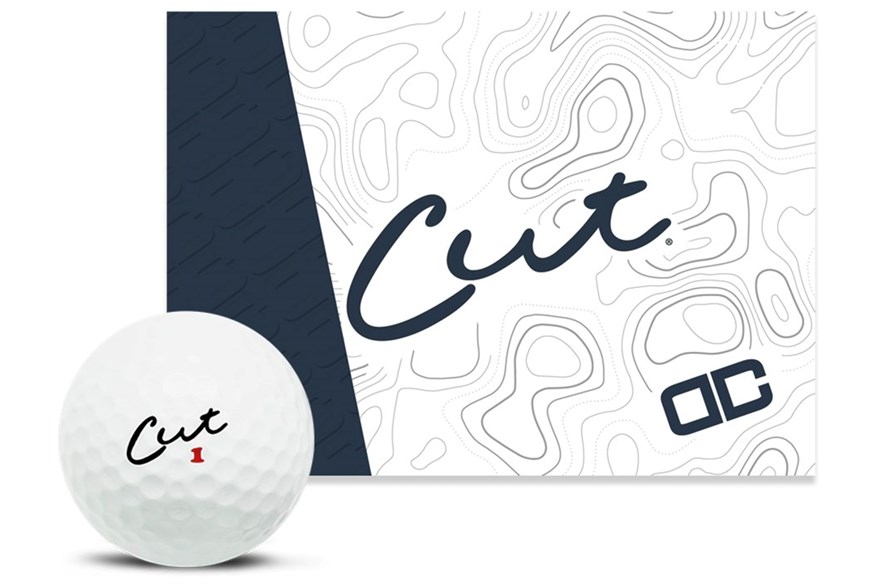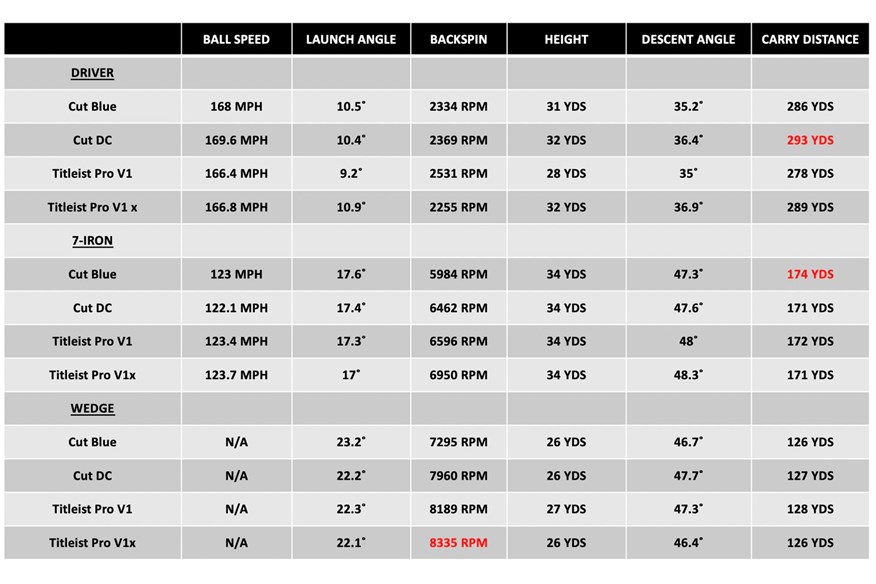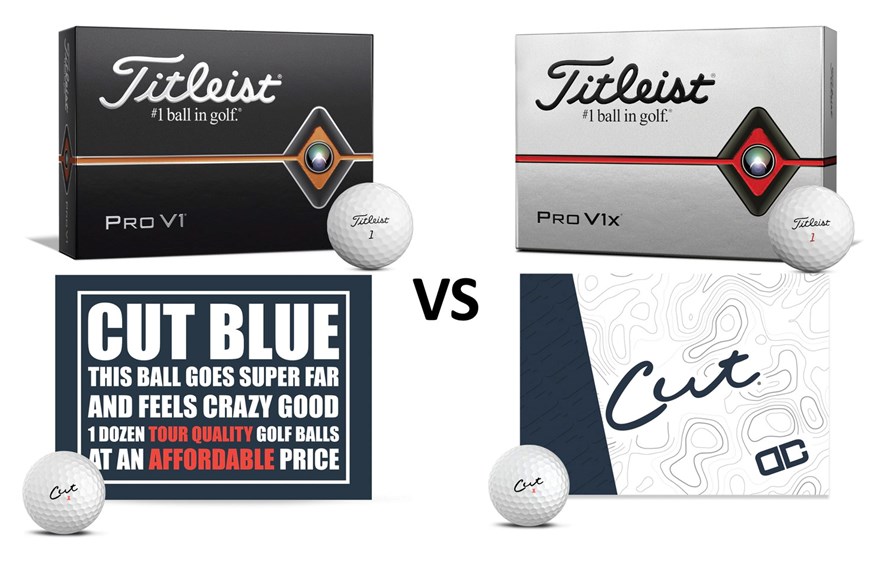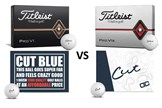Cut Golf vs Titleist Pro V1 golf balls
Last updated:
Cut Golf claim their balls offer performance to match any premium golf ball, but at a fraction of the price. We put them to the test against the market-leading Titleist Pro V1.
The rise of direct-to-consumer golf balls
There’s a fair chance you’ve never heard of Cut Golf. Compared to established brands like Titleist, Callaway and TaylorMade, all of whom have been making golf balls for decades, Cut Golf are a relative newcomer to the market.
RELATED: Revealed – The right golf ball for your game
In fact, not too long ago, the only golf balls you could buy were big-name brands from big-name retailers. But times have changed.
Direct to consumer (DTC) golf balls – from brands you won’t find in any retail shop – are growing in popularity because they offer premium performance at budget prices.
Over the last few years we’ve done quite a bit of testing with Snell and Vice balls, both available online only. Last year we tested them on a robot alongside the most popular balls in the business, and both were more than a match for market-leading models.
Brands like Snell and Vice, as well as Seed and Cut Golf, have adopted a business model that enables them to manufacture golf balls in far flung factories, using very similar materials and technology to tour-backed alternatives, while minimising costs to produce savings that can be passed on to the consumer.
Related: Vice Golf vs Titleist Pro V1 golf balls
These DTC golf ball companies have no retailer margins, no tour endorsements and no enormous R&D budgets, which means pricing can be much more competitive.
Enter Cut Golf
Cut Golf has adopted that model and claim to have created “A Ball for the People”.
Cut Golf was born out of Sam Uisprapassorn’s frustrations at being so inconsistent he was losing four or five balls a round. Cut Golf is based in the USA, they’ve been in business since early 2017 and their goal from day one has always been about making “the best damn golf balls for under $20 a dozen”.
We decided to put Cut Golf’s claims to the test and compare their golf balls head-to-head against the market-leading Titleist Pro V1 franchise.
Related: Best Winter Golf Balls
Cut Golf make a wide range of balls aimed at different types of golfers. We’ve chosen the models in this test – the Cut DC and Cut Blue – because they’re the direct tour-level competitors to the two Titleist Pro V1 balls. Seed, Cut and Vice also make softer, lower compression balls which boast the same technology, but are specifically designed to perform at more average club golfer swing speeds – we’ll test those with a club golfer at another time.
How we did it
TG test pro Neil Wain hit shots with his own Ping i210 wedge, 7-iron and G410 Plus driver indoors to ensure a controlled environment. We used a Foresight Sports GC Quad launch monitor to record data.
Related: Callaway Chrome Soft vs Titleist Pro V1 golf balls
Cut DC golf balls
Price: £29.95 per dozen (shipping is £2.90 regardless of how many boxes you order)
Construction: Four-piece
Cover material: Urethane
Compression: 105

The Cut DC is the newest ball in Cut Golf’s range. It is a four-piece golf ball with 105 compression and has been designed to suit players of all skill levels. It’s closest comparison in Titleist’s range is the Titleist Pro V1x.
Key numbers: Cut DC golf ball vs Titleist Pro V1x
42% cheaper than a Titleist Pro V1x
1.4% more driver carry distance than the comparable Pro V1x (5.4% more than the Pro V1)
Equal iron distance to the comparable Pro V1x (0.6% less than the Pro V1)
4.5% less wedge spin than the comparable Pro v1x (2.8% less than the Pro V1)
Cut Blue golf balls
Price: £19.95 per dozen (shipping is £2.90 regardless of how many boxes you order)
Construction: Four-piece
Cover material: Urethane
Compression: 90

The Cut Blue has a softer compression than the Cut DC (90 compression) and delivers a lower ball flight. The Cut Blue is aimed at average and above average swing speeds; Cut also make the Cut Grey which targets more moderate swing speeds.
Key numbers: Cut Blue golf ball vs Titleist Pro V1
62% cheaper than a Pro V1
2.9% more driver carry distance than the comparable Pro V1 (1% less than the Pro V1x)
1.2% more iron distance than the comparable Pro V1 (1.8% more than the Pro V1x)
10.9% less wedge spin than the comparable Pro V1 (12.5% less than the Pro V1x)
Verdict: Cut Golf Balls
The Cut DC would be our choice between the two models.
The Cut Blue generated the longest distances with a 7-iron and the second lowest spin numbers with the driver (in our recent DTC Golf Ball Test), out-pacing the comparative Pro V1 by eight yards with the driver and two yards with an iron, which is significant. But the Cut Blue also span 900rpm less than the Titleist Pro V1 on wedge shots (a 10.9% difference), generating the lowest spin of all four balls with irons and wedges. That will lead to a reduction in control on approach shots which good players won’t want.
The Cut DC golf ball, on the other hand, excelled across the board.
Related: TaylorMade Tour Response vs Titleist Pro V1 golf balls
It produced the longest distances with the driver, posting an extra 2.8mph of ball speed and an extra four yards of carry distance over the second longest ball of the four, the Titleist Pro V1x.
It matched the Titleist Pro V1x for distance with irons, and gave up just 375pm of spin on wedge shots.
Our test pro Neil Wain was bowled over by the high ball flight he generated with his driver using the Cut DC, which he felt would help him carry hazards off the tee.
Related: The most forgiving irons
Data comparison: Cut Golf vs Titleist Pro V1 and Pro V1x golf balls

What did we learn from our DTC golf ball test?
Don’t sacrifice wedge spin
If you play the Titleist Pro V1 because you believe it gives the most spin with a wedge, think again. Just as our robot ball test revealed last year, you get more backspin/control from the firmer Pro V1x. We’re only talking between 2-4% more, but it’s the 11 yards you give up with a driver compared to the Pro V1x that really hurts with a Pro V1.
The Taiwan connection
A glance at the boxes our golf balls arrived in shows several are made in Taiwan. Investment levels required to construct a golf ball plant are significant, so while Titleist, Callaway and Srixon all own theirs, plenty of others share a factory. What’s our point? Well, as long as there’s a major brand using the same factory, significant quality control procedures will be in place. So small brands can piggyback on the consistency and quality of a major player.
Related: Srixon Q-Star Tour vs Titleist Pro V1 golf balls
Commit to one ball
We’ve said it a million times, but right now there couldn’t be a better time to commit to using the same ball every time you play. It gives consistency and similar results, which for most club golfers would be a decent step forward from using the different balls they find. DTC brands often offer discounts when you buy more, so if you can invest in five dozen for the year, it means you’ll get the best possible price, too.
Can you tell the difference?
It’s difficult conducting a “Pepsi challenge” blind test on golf balls as dimple patterns and logos can’t easily be neutralised, but our test pro said he’d be amazed if a club golfer could spot the difference between any of our tour-level test balls and a Pro V1 based on feel alone. After all, he couldn’t. There can’t be a better endorsement of how far DTC golf balls have come than that.
Related: Callaway Chrome Soft vs Titleist Pro V1 golf balls
They’re all conforming
Over the years we’ve seen plenty of balls go up against the Pro V1, but they’ve always come with a “they’re just as good as a Titleist” sub-story. This is the first time we’ve seen Titleist’s market leading designs out-performed in areas they’re supposed to dominate, which is a milestone. And all of the Cut golf balls conform to USGA and R&A rules too.
Related: Robot tested – Which golf ball suits your game?

Review written by: Simon Daddow
Job title: Today’s Golfer – Equipment Editor








